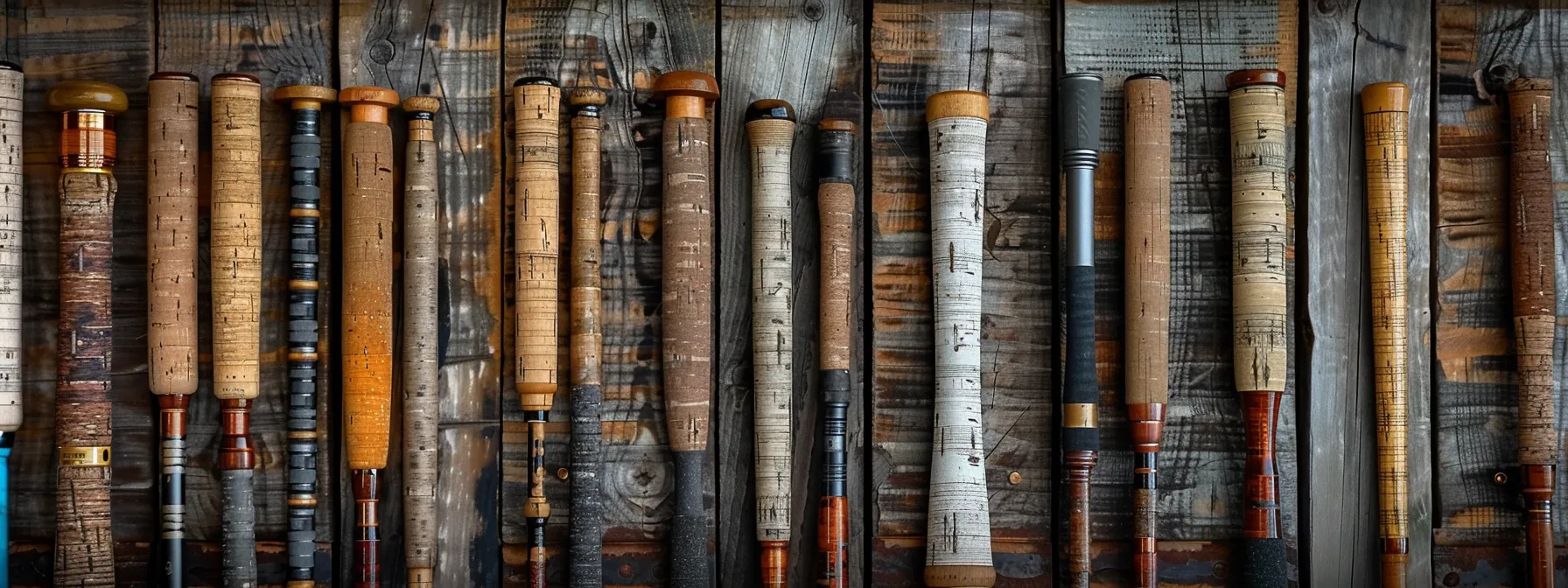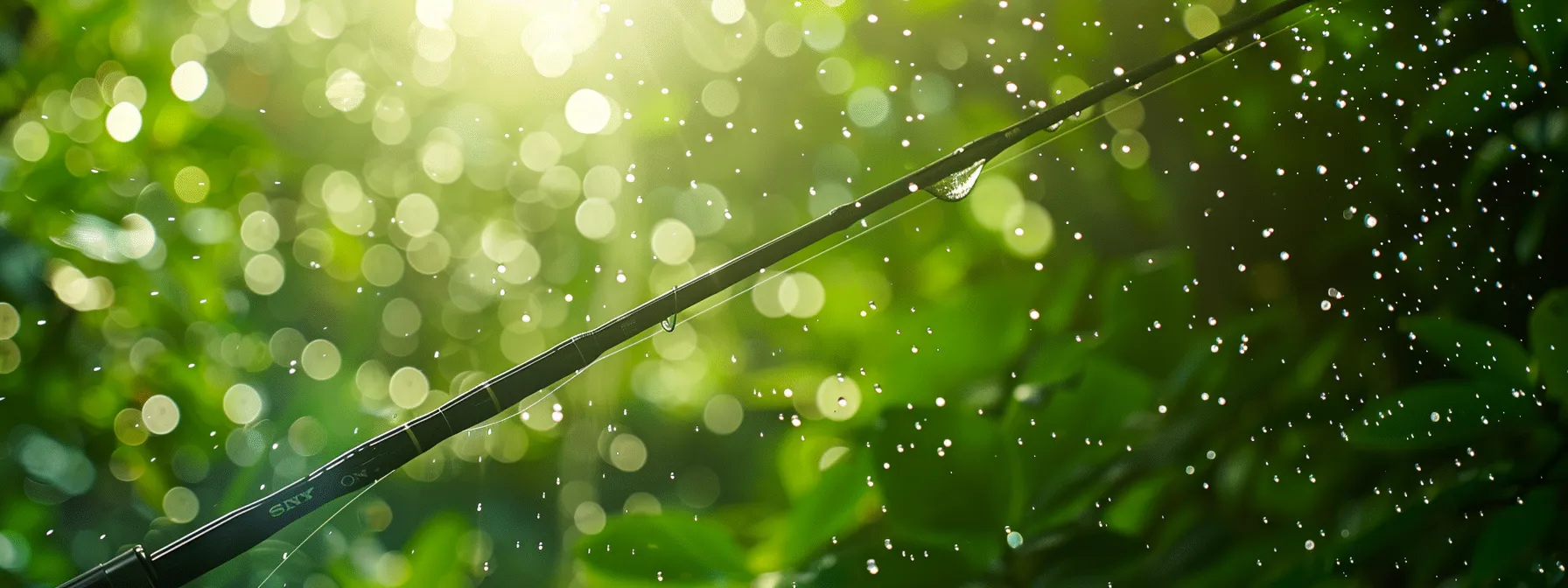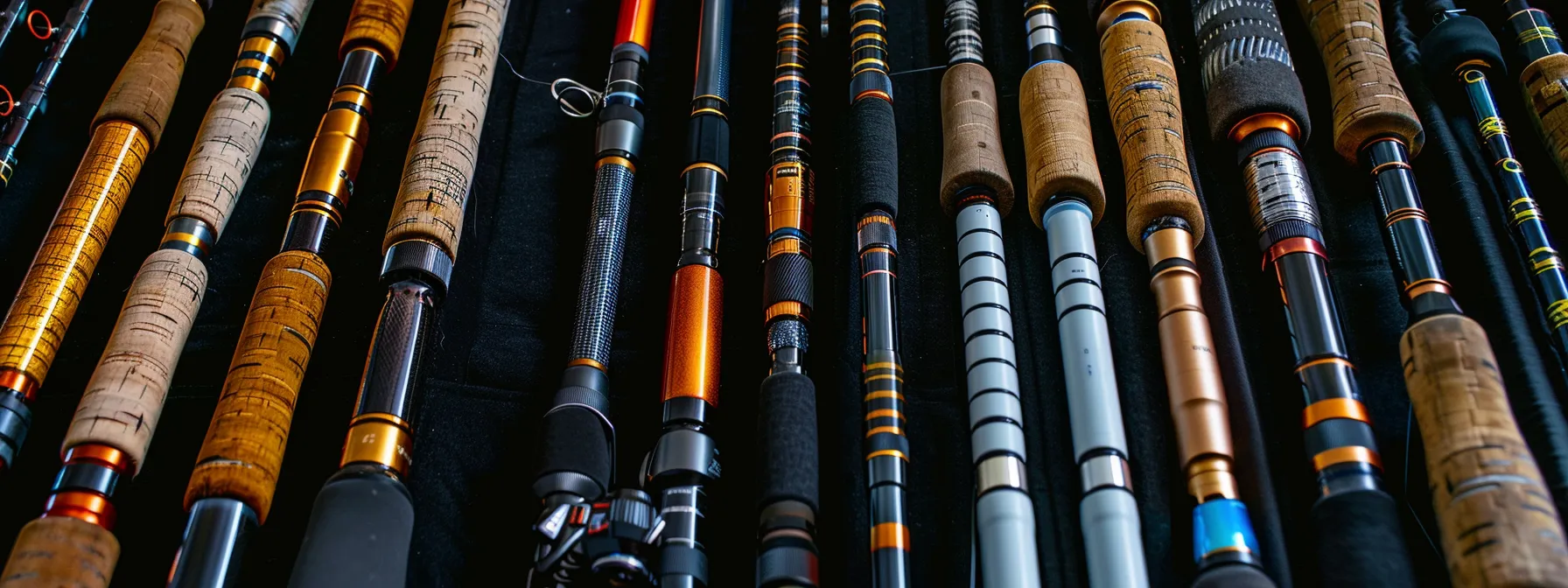Choosing the right fishing rod material can make or break your fishing experience. Did you know that the material of your rod significantly impacts its performance and durability? In this guide, I’ll break down the common fishing rod materials, including mixtures of graphite, fiberglass, and even ceramic options, and discuss their pros and cons. You’ll learn how to select the ideal rod material for your needs, ensuring your fishing reel works seamlessly with your setup. By the end, you’ll have the knowledge to tackle any fishing challenge with confidence.
Understanding the Role of Rod Material in Fishing Success

The material of your fishing rod plays a crucial role in your overall success on the water. It directly impacts casting distance and accuracy, allowing you to reach those hard-to-reach spots. Additionally, the right material enhances sensitivity and bite detection, making it easier to feel even the slightest nibble. Durability factors linked to materials, such as elasticity and epoxy manufacturing, also ensure your rod can withstand the test of time and the weight of the fish you’re targeting.
In the following sections, I’ll dive deeper into how different materials affect these aspects, helping you choose the perfect rod for your fishing techniques and the pound test you plan to use.
How Material Affects Casting Distance and Accuracy
The material of your fishing rod significantly influences casting distance and accuracy, especially when targeting species like bass in a pond. For instance, a rod made from high-quality graphite offers a lightweight design that allows for longer casts with less effort, making it easier to reach those distant spots where fish are hiding. Additionally, the right rod material enhances the frequency of your casts, improving your overall fishing tackle performance and increasing your chances of detecting subtle bites on your tippet.
The Influence of Material on Sensitivity and Bite Detection
The material of your fishing rod plays a vital role in sensitivity and bite detection, especially when you're out there dry Fly Fishing or using a jig. For instance, rods made from high-quality carbon fiber are known for their excellent sensitivity, allowing me to feel even the faintest nibble. When choosing a brand, consider your personal preference for rod material, as it can significantly enhance your ability to detect bites and improve your overall fishing experience.
- High-quality carbon fiber enhances sensitivity.
- Material choice impacts bite detection.
- Personal preference influences rod selection.
- Rods designed for dry fly fishing offer specific advantages.
- Using a jig requires a sensitive rod for optimal performance.
Durability Factors Linked to Rod Materials
When it comes to durability, the material of your fishing rod is paramount, especially if you're targeting walleye in the Great Lakes. I’ve found that rods made from high-quality graphite or carbon fiber not only withstand the rigors of fishing but also maintain their performance over time. For instance, a rod with a cork handle can provide a comfortable grip while ensuring that the gear remains intact, even when using a fishing float or battling a strong catch. Choosing the right material means investing in a rod that will last, allowing you to focus on enjoying your time on the water without worrying about equipment failure.
The material of your rod shapes your experience on the water. Let’s look at the common types and see which one might be right for you.
Overview of Common Fishing Rod Materials

When selecting the right fishing rod material, it's essential to understand the options available. I’ll explore fiberglass rods, known for their durability and flexibility, ideal for catching panfish. Next, I’ll discuss graphite rods, which offer lightweight performance and sensitivity, perfect for targeting largemouth bass. Composite rods combine the best of both worlds, while bamboo rods provide a classic touch with unique benefits. Each material has its advantages, so let’s dive into the details.
Exploring Fiberglass Rods
Fiberglass rods are a solid choice for anglers seeking durability and flexibility in their fishing gear. These rods are often made with a resin that enhances their strength, making them ideal for various fishing techniques, including using swimbaits and plugs. I’ve found that fiberglass rods excel when paired with the right fishing bait, as they provide a forgiving action that helps prevent breakage when battling larger fish, ensuring that your fish hook stays secure during the fight.
- Durability and flexibility make fiberglass rods a reliable option.
- Resin enhances the strength of the rod.
- Ideal for techniques using swimbaits and plugs.
- Forgiving action helps prevent breakage.
- Great for securing fish hooks during battles.
Characteristics of Graphite Rods
Graphite rods are a top choice for anglers looking to enhance their recreational fishing experience, especially when targeting game fish like trout. Their lightweight design allows for effortless casting, making them ideal for techniques such as spin fishing with spinnerbaits. I’ve found that the sensitivity of graphite rods significantly improves bite detection, allowing me to feel even the slightest nibbles, which is crucial when fishing in competitive environments.
The Benefits of Composite Rods
Composite rods offer a unique blend of materials, often incorporating titanium and stainless steel in their construction. This combination enhances the ultimate tensile strength of the rod, making it both lightweight and incredibly durable. I’ve found that these rods provide excellent drag control, allowing for smooth line management when battling larger fish, which is essential for a successful day on the water.
Insights Into Bamboo Rods
Bamboo rods offer a unique blend of tradition and performance, making them a favorite among many anglers. Their natural flexibility allows for a smooth bending action, which is particularly beneficial during the hook set, as it helps absorb the shock of a fish's initial strike. While bamboo rods may not incorporate modern materials like carbon fibers or steel, their length and craftsmanship provide a distinct feel that can enhance your fishing experience, especially when targeting species that require a delicate touch.
- Bamboo rods provide a traditional feel and performance.
- Natural flexibility aids in smooth bending during hook sets.
- They offer a unique experience compared to modern materials.
- Length and craftsmanship enhance the overall fishing experience.
- Ideal for targeting species that require a delicate touch.
Now that we’ve explored the common materials used in fishing rods, it’s time to weigh their strengths and weaknesses. Understanding the pros and cons of each will help you choose the right rod for your next adventure.
Pros and Cons of Different Rod Materials

Pros and Cons of Different Rod Materials
When selecting the right fishing rod material, it's essential to weigh the advantages and limitations of each option. Fiberglass rods offer durability but can be heavier, while graphite rods provide excellent sensitivity and casting performance, though they may lack some flexibility. Composite rods blend strengths from various materials, enhancing performance, and bamboo rods bring a traditional feel with unique benefits. Let’s explore these aspects in detail.
Advantages and Limitations of Fiberglass
Fiberglass rods are a solid choice for anglers who prioritize durability and flexibility without breaking the bank. Their price point often makes them accessible for beginners and seasoned anglers alike. However, one limitation I’ve noticed is their stiffness compared to graphite rods, which can affect sensitivity and bite detection. While fiberglass is less brittle than some materials, it may not perform as well in high-stress situations, such as battling larger fish. Overall, if you’re looking for a reliable rod that can handle various fishing techniques, fiberglass is worth considering, especially if you’re using brands like Orvis that are known for quality craftsmanship.
Strengths and Weaknesses of Graphite
Graphite fishing rods are a favorite among many anglers due to their lightweight design and exceptional sensitivity. This material allows for longer casts with less effort, making it easier to reach those elusive fish. However, while graphite offers excellent performance, it can be more brittle than other materials like fiberglass or metal, which means it may not withstand rough handling as well. If you're considering a graphite rod, keep in mind that while it excels in sensitivity and casting distance, it may require a bit more care to avoid damage:
- Lightweight design enhances casting distance.
- Exceptional sensitivity improves bite detection.
- More brittle than fiberglass or metal, requiring careful handling.
- Ideal for targeting species that demand finesse.
- Not as forgiving in high-stress situations.
Evaluating Composite Rod Performance
When evaluating composite rod performance, I find that these rods offer a remarkable balance of strength and sensitivity, making them a favorite among many fishermen. The combination of materials, often including graphite and fiberglass, allows for excellent handling of stress during intense battles, especially when using a monofilament fishing line. Whether I'm fly fishing in a reservoir or targeting larger species, the versatility of composite rods ensures I can adapt to various fishing conditions with confidence.
- Composite rods provide a balance of strength and sensitivity.
- They handle stress well during intense battles.
- Versatile for different fishing techniques, including fly fishing.
- Ideal for use with monofilament fishing line.
- Great for various fishing environments, such as reservoirs.
Weighing the Options With Bamboo
Bamboo rods offer a unique blend of tradition and performance, making them an appealing choice for anglers who appreciate craftsmanship. When fishing in a lake, the natural flexibility of bamboo allows for smooth tension management, enhancing accuracy and precision during the hook set. While they may not be as lightweight as aluminium or modern materials, bamboo rods provide a distinct feel that can elevate your fly fishing experience, especially when targeting species that require a delicate touch.
- Bamboo rods provide a traditional feel and performance.
- Natural flexibility aids in smooth tension management.
- Enhances accuracy and precision during hook sets.
- Ideal for fly fishing in lakes.
- Offers a unique experience compared to aluminium and modern materials.
Choosing the right rod material can make all the difference in your fishing experience. Let’s look at how to select the ideal rod material that fits your needs and enhances your time on the water.
Selecting the Ideal Rod Material for Your Needs

When selecting the ideal rod material, I focus on several key factors. First, I assess my fishing style and technique, whether I'm targeting rainbow trout with an artificial fly or crappie in a local lake. Next, I match the material to the species I'm after, considering how environmental conditions, like water type and weather, can impact my choice. Finally, I balance cost with the desired features to ensure I get the best value for my investment.
Assessing Your Fishing Style and Technique
When assessing your fishing style and technique, it's essential to consider the species you're targeting and the type of fishing line you'll be using. For instance, if I'm targeting delicate species like trout, I often opt for a lightweight bamboo rod that offers a smooth action, allowing for precise casts. On the other hand, if I'm using heavier tackle for larger fish, I might choose a rod with a stronger mandrel to handle the added weight and stress during the fight.
- Identify the species you want to catch.
- Consider the type of fishing line you'll use.
- Match the rod material to your fishing technique.
- Evaluate the weight of the tackle for optimal performance.
- Choose a rod that complements your personal fishing style.
Matching Material to Target Species
When matching rod material to the species I'm targeting, I consider the specific needs of each type of fish. For instance, when I'm after bass, I often choose a graphite rod for its sensitivity and lightweight design, which allows for quick, accurate casts. On the other hand, for fly fishing, I prefer a bamboo rod that offers a smooth action, enhancing my ability to present delicate flies effectively. Additionally, I always keep essential Fishing Accessories, like Replacement Rubber Nets, handy to ensure I can handle my catch without damaging it, making my fishing experience more enjoyable and successful.
Considering Environmental Conditions
When considering environmental conditions, I always take into account factors like water type, weather, and the specific habitat where I’ll be fishing. For example, if I’m fishing in a windy area, a heavier rod made from graphite can help me maintain control and accuracy in my casts. Additionally, using tools like the Fish Whistle Tool can assist in managing my catch effectively, while a Bead Chart Coaster can help me keep track of my bait and tackle in varying conditions, ensuring I’m prepared for whatever the day brings.
Balancing Cost With Desired Features
When balancing cost with desired features in fishing rod materials, I always consider what I truly need for my fishing style. For instance, while a high-end graphite rod may offer exceptional sensitivity and casting distance, I’ve found that a well-made fiberglass rod can provide the durability I need without breaking the bank. It’s essential to evaluate how often I fish and the types of species I target, ensuring that I invest in a rod that meets my performance expectations while staying within my budget.
You’ve chosen your rod material, but the real test lies ahead. Let’s dive into how these materials perform when put to the test.
Testing and Comparing Rod Materials

When it comes to choosing the right fishing rod material, hands-on tips for evaluating rods can make a significant difference. I’ll guide you through understanding manufacturer specifications, which provide essential insights into performance. Additionally, I’ll show you how to read and interpret reviews and testimonials, helping you make an informed decision that aligns with your fishing needs.
Hands-on Tips for Evaluating Rods
When evaluating fishing rods, I always recommend physically handling them to get a true sense of their weight and balance. A rod that feels comfortable in your hands can make a significant difference during long fishing sessions. Pay attention to the action and flexibility by gently bending the rod; this will help you understand how it will perform when casting or fighting a fish. Additionally, checking the manufacturer’s specifications can provide insights into the materials used and their intended purpose, ensuring you choose a rod that aligns with your fishing style and needs.
Understanding Manufacturer Specifications
When I evaluate fishing rods, understanding manufacturer specifications is key to making an informed choice. These specifications often detail the materials used, rod action, and power ratings, which directly impact performance. For example, a rod labeled as "fast action" will respond quickly, making it ideal for techniques that require precision, while a "medium action" rod offers more flexibility, suitable for a variety of fishing styles. By paying attention to these details, I can select a rod that aligns perfectly with my fishing needs and enhances my overall experience on the water.
Reading and Interpreting Reviews and Testimonials
When I read reviews and testimonials about fishing rods, I focus on the experiences shared by other anglers. These insights often highlight the performance of different materials in real-world conditions, helping me understand how a rod might perform when I'm out on the water. I pay attention to comments about sensitivity, durability, and casting distance, as these factors are crucial for my fishing success. By considering both positive and negative feedback, I can make a more informed decision that aligns with my specific fishing needs and preferences.
After testing and comparing rod materials, it’s clear that each has its strengths. Now, let’s talk about how to care for your fishing rod, ensuring it lasts through many adventures.
Caring for Your Fishing Rod Material

Caring for your fishing rod material is essential for ensuring its longevity and performance. I’ll cover key maintenance practices that keep your rod in top shape, proper storage techniques based on the material type, and how to repair common issues specific to each material. These insights will help you protect your investment and enhance your fishing experience.
Maintenance Practices for Longevity
To ensure the longevity of your fishing rod, I always recommend a few simple maintenance practices. After each fishing trip, I rinse my rod with fresh water to remove any salt, dirt, or debris that could cause damage over time. Additionally, I check the guides and reel seat for any signs of wear or corrosion, as these areas can affect performance. Regularly applying a light coat of rod wax can also help protect the finish and keep it looking new, allowing me to focus on enjoying my time on the water without worrying about my gear.
Proper Storage Based on Material Type
Proper storage of your fishing rod is essential to maintain its performance and longevity, and it varies based on the material type. For graphite and composite rods, I recommend storing them in a rod tube or rack to prevent bending or breaking, as these materials can be more brittle. On the other hand, fiberglass rods can be stored upright in a corner or on a rack, as their durability allows for a bit more flexibility in storage options. Regardless of the material, always ensure your rods are kept in a cool, dry place away from direct sunlight to protect them from damage and ensure they’re ready for your next fishing adventure.
Repairing Common Material-Specific Issues
Repairing common material-specific issues is essential for maintaining the performance of your fishing rod. For instance, if I notice a small crack in my graphite rod, I carefully clean the area and apply a specialized rod repair epoxy to seal it, ensuring it remains strong and functional. Similarly, if the guides on my fiberglass rod become loose, I reattach them using a strong adhesive, which helps prevent further damage and keeps my rod ready for action on the water.
Conclusion
Choosing the right fishing rod material is crucial for enhancing your performance on the water. Each material—whether fiberglass, graphite, composite, or bamboo—offers unique advantages that can significantly impact casting distance, sensitivity, and durability. By understanding your fishing style, target species, and environmental conditions, you can select a rod that meets your specific needs. Investing in the perfect rod material not only improves your fishing experience but also ensures you’re well-equipped to tackle any challenge that comes your way.


